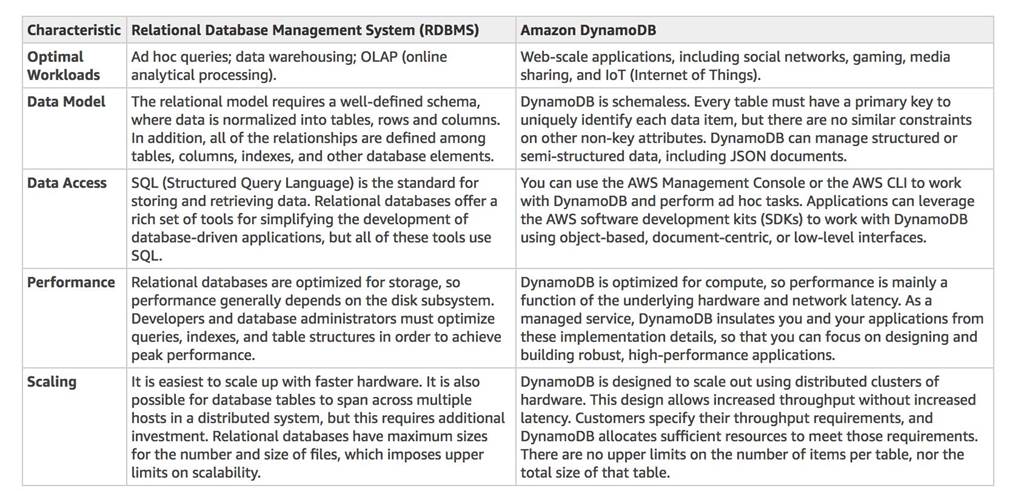- All Exams Instant Download
Which is the most suitable database solution to use to achieve this requirement?
A company is in the process of migrating their applications to AWS. One of their systems requires a database that can scale globally and handle frequent schema changes. The application should not have any downtime or performance issues whenever there is a schema change in the database. It should also provide a low latency response to high-traffic queries.
Which is the most suitable database solution to use to achieve this requirement?
A . An Amazon RDS instance in Multi-AZ Deployments configuration
B . Amazon DynamoDB
C . Redshift
D . An Amazon Aurora database with Read Replicas
Answer: B
Explanation:
Before we proceed in answering this question, we must first be clear with the actual definition of a "schema". Basically, the english definition of a schema is: a representation of a plan or theory in the form of an outline or model.
Just think of a schema as the "structure" or a "model" of your data in your database. Since the scenario requires that the schema, or the structure of your data, changes frequently, then you have to pick a database which provides a non-rigid and flexible way of adding or removing new types of data. This is a classic example of choosing between a relational database and non-relational (NoSQL) database.

A relational database is known for having a rigid schema, with a lot of constraints and limits as to which (and what type of ) data can be inserted or not. It is primarily used for scenarios where you have to support complex queries which fetch data across a number of tables. It is best for scenarios where you have complex table relationships but for use cases where you need to have a flexible schema, this is not a suitable database to use.
For NoSQL, it is not as rigid as a relational database because you can easily add or remove rows or elements in your table/collection entry. It also has a more flexible schema because it can store complex hierarchical data within a single item which, unlike a relational database, does not entail changing multiple related tables. Hence, the best answer to be used here is a NoSQL database, like DynamoDB. When your business requires a low-latency response to high-traffic queries, taking advantage of a NoSQL system generally makes technical and economic sense.
Amazon DynamoDB helps solve the problems that limit the relational system scalability by avoiding them. In DynamoDB, you design your schema specifically to make the most common and important queries as fast and as inexpensive as possible. Your data structures are tailored to the specific requirements of your business use cases.
Remember that a relational database system does not scale well for the following reasons:
– It normalizes data and stores it on multiple tables that require multiple queries to write to disk.
– It generally incurs the performance costs of an ACID-compliant transaction system.
– It uses expensive joins to reassemble required views of query results.
For DynamoDB, it scales well due to these reasons:
– Its schema flexibility lets DynamoDB store complex hierarchical data within a single item. DynamoDB is not a totally schemaless database since the very definition of a schema is just the model or structure of your data.
– Composite key design lets it store related items close together on the same table.
An Amazon RDS instance in Multi-AZ Deployments configuration and an Amazon Aurora database with Read Replicas are incorrect because both of them are a type of relational database. Redshift is incorrect because it is primarily used for OLAP systems.
References:
https://docs.aws.amazon.com/amazondynamodb/latest/developerguide/bp-general-nosql-design.html
https://docs.aws.amazon.com/amazondynamodb/latest/developerguide/bp-relational-modeling.html
https://docs.aws.amazon.com/amazondynamodb/latest/developerguide/SQLtoNoSQL.html
Also check the AWS Certified Solutions Architect Official Study Guide: Associate Exam 1st Edition and turn to page 161 which talks about NoSQL Databases. Check out this Amazon DynamoDB Cheat Sheet:
https://tutorialsdojo.com/amazon-dynamodb
Tutorials Dojo’s AWS Certified Solutions Architect Associate Exam Study Guide:
https://tutorialsdojo.com/aws-certified-solutions-architect-associate/
Latest SAA-C03 Dumps Valid Version with 400 Q&As
Latest And Valid Q&A | Instant Download | Once Fail, Full Refund
Subscribe
Login
0 Comments
Inline Feedbacks
View all comments

